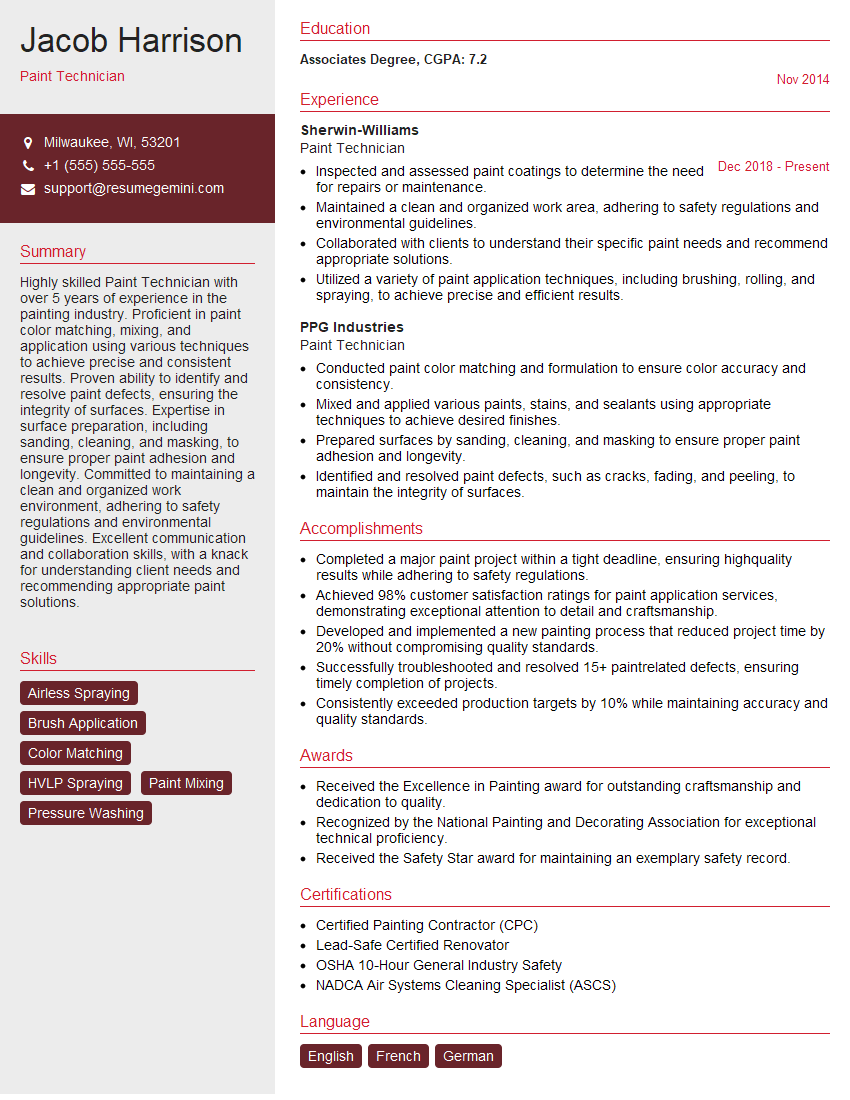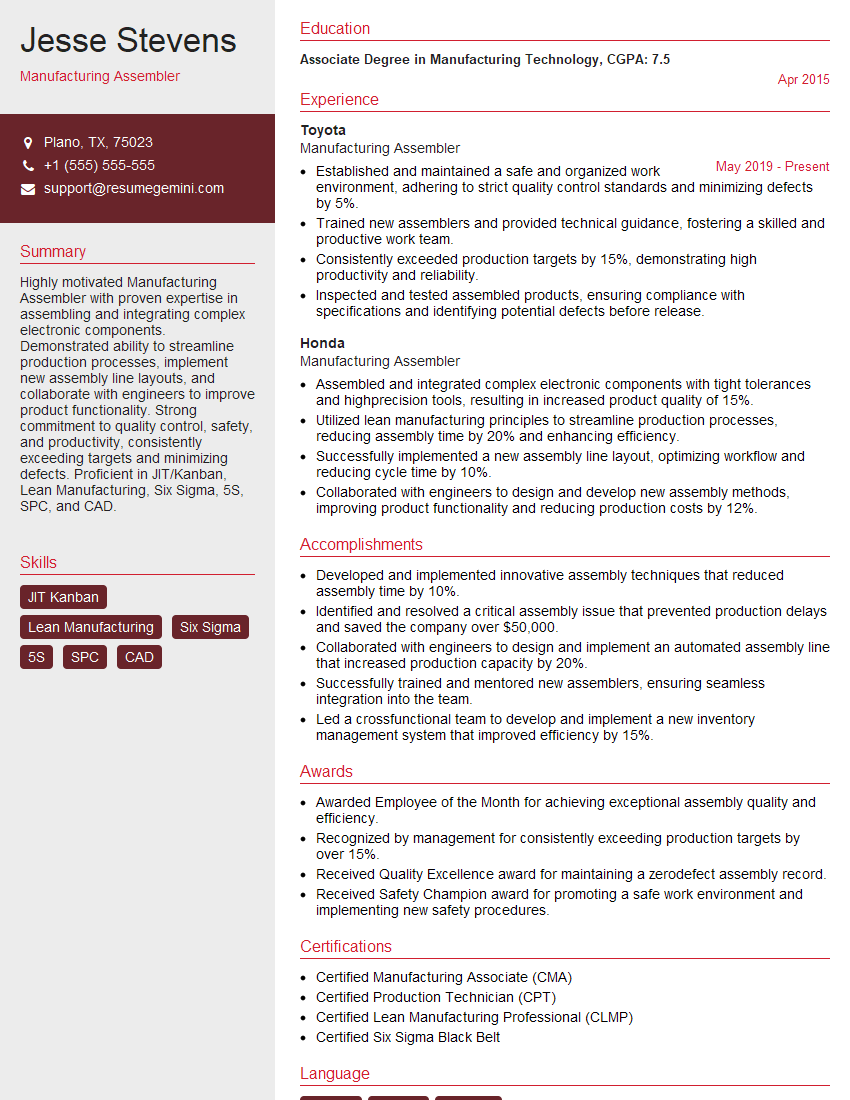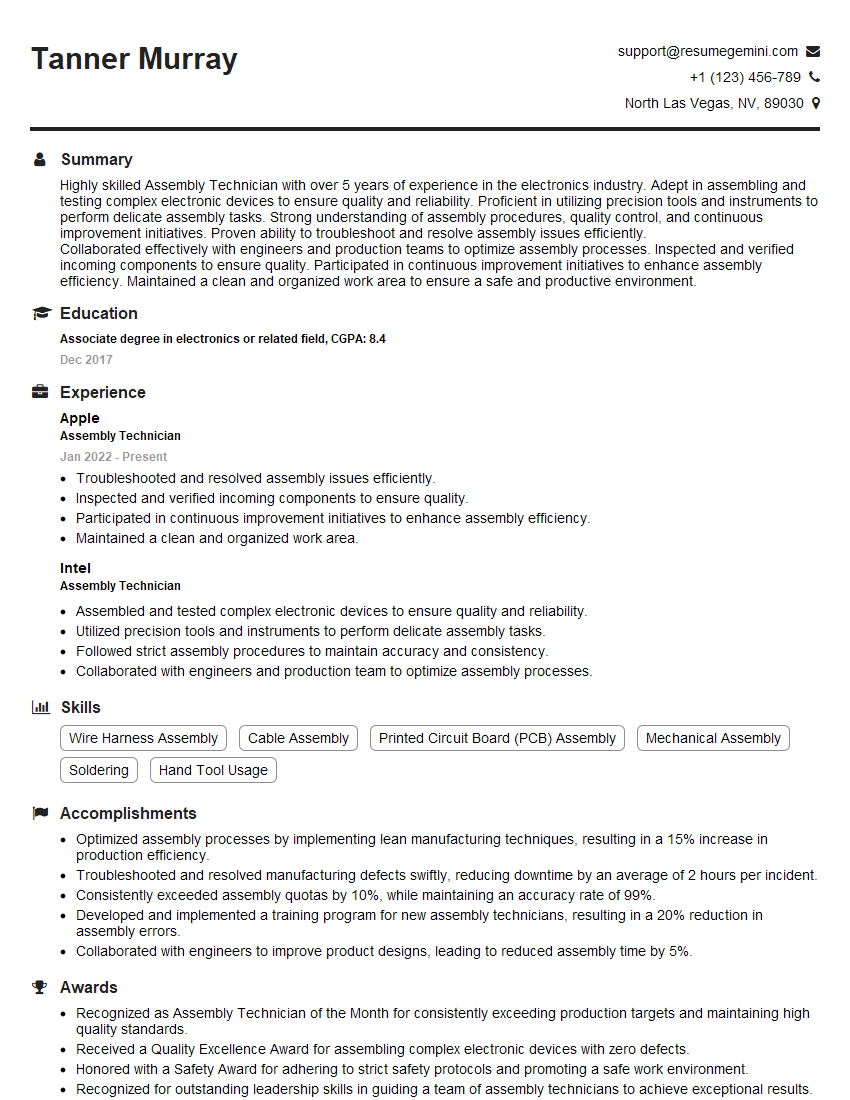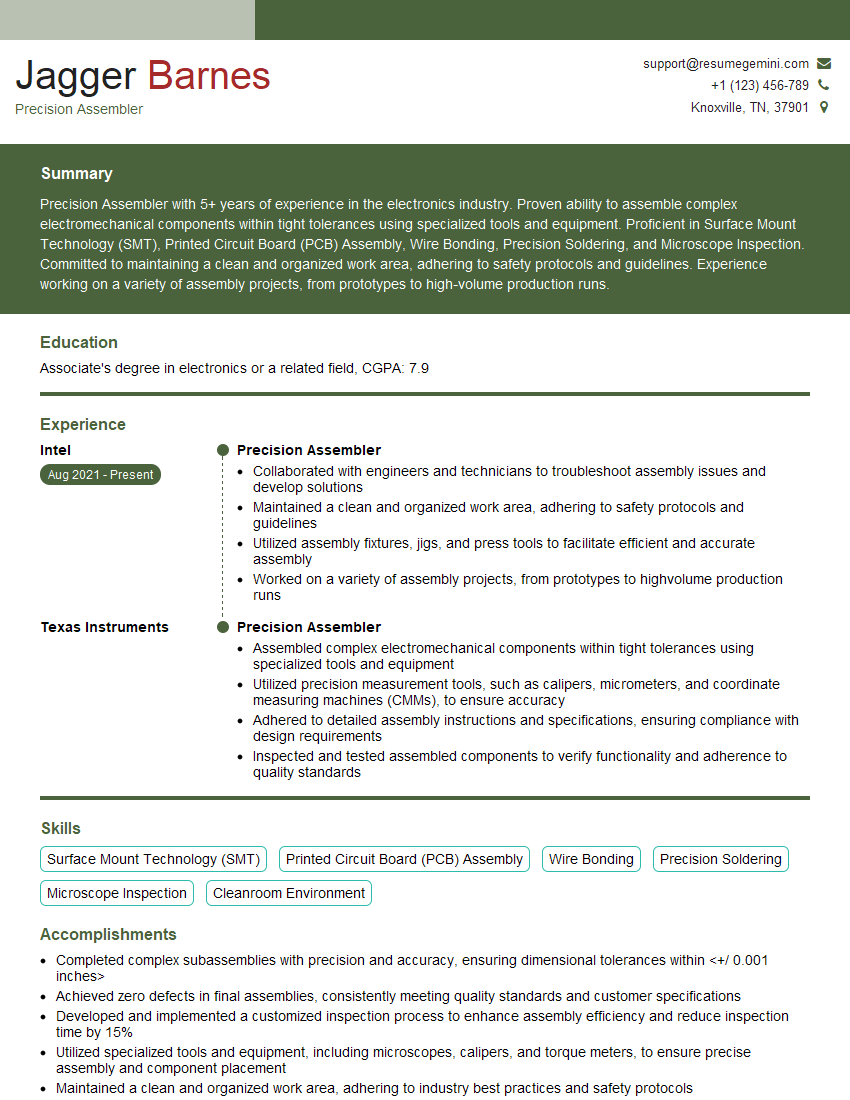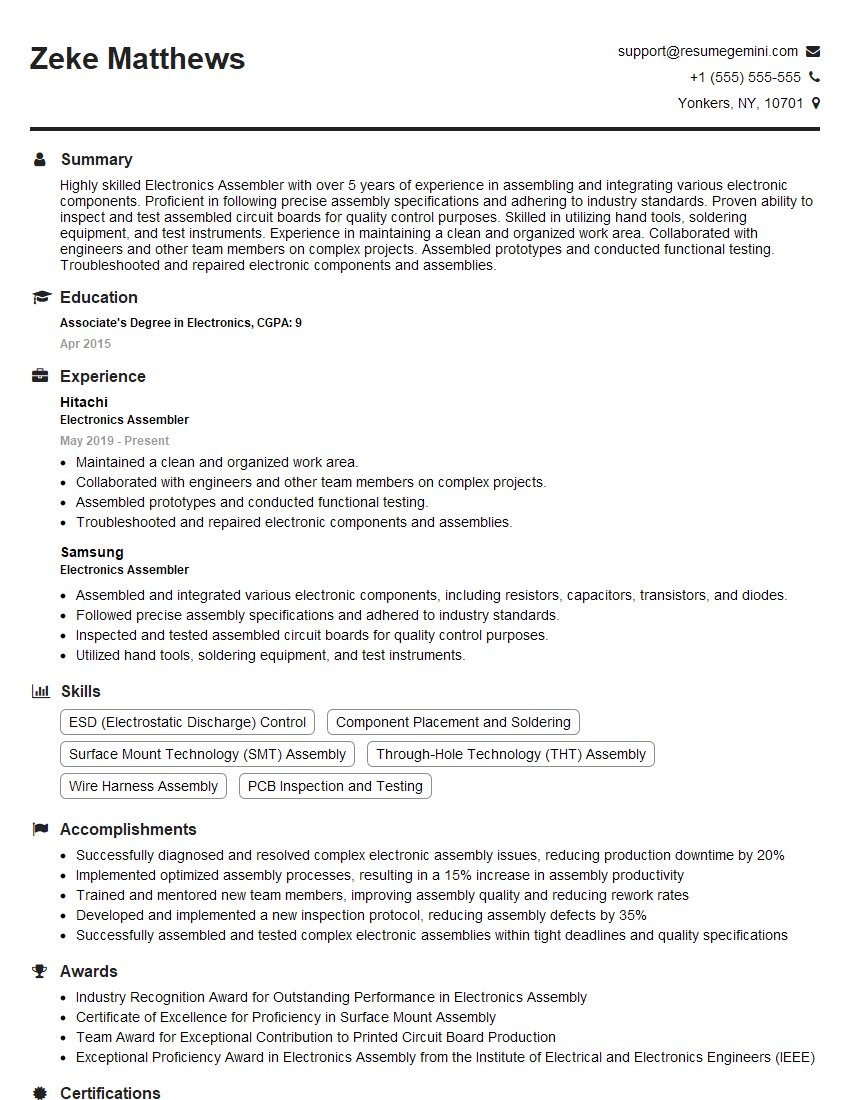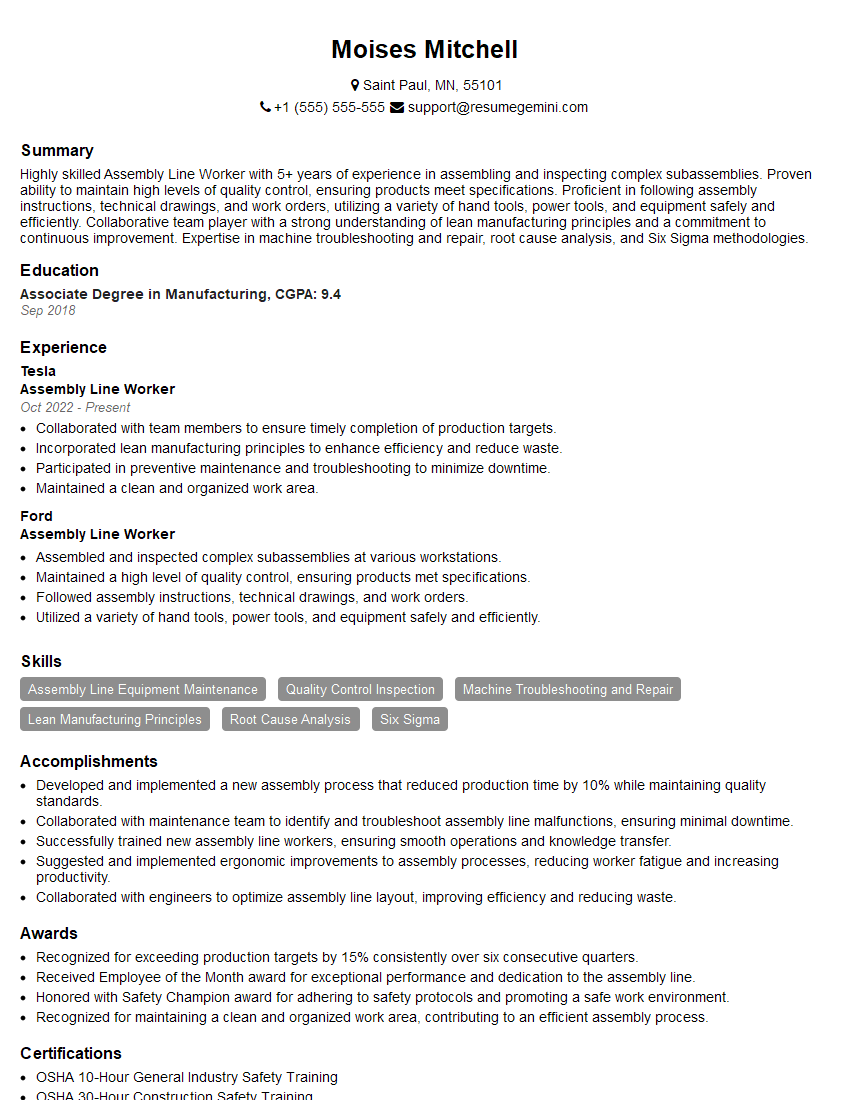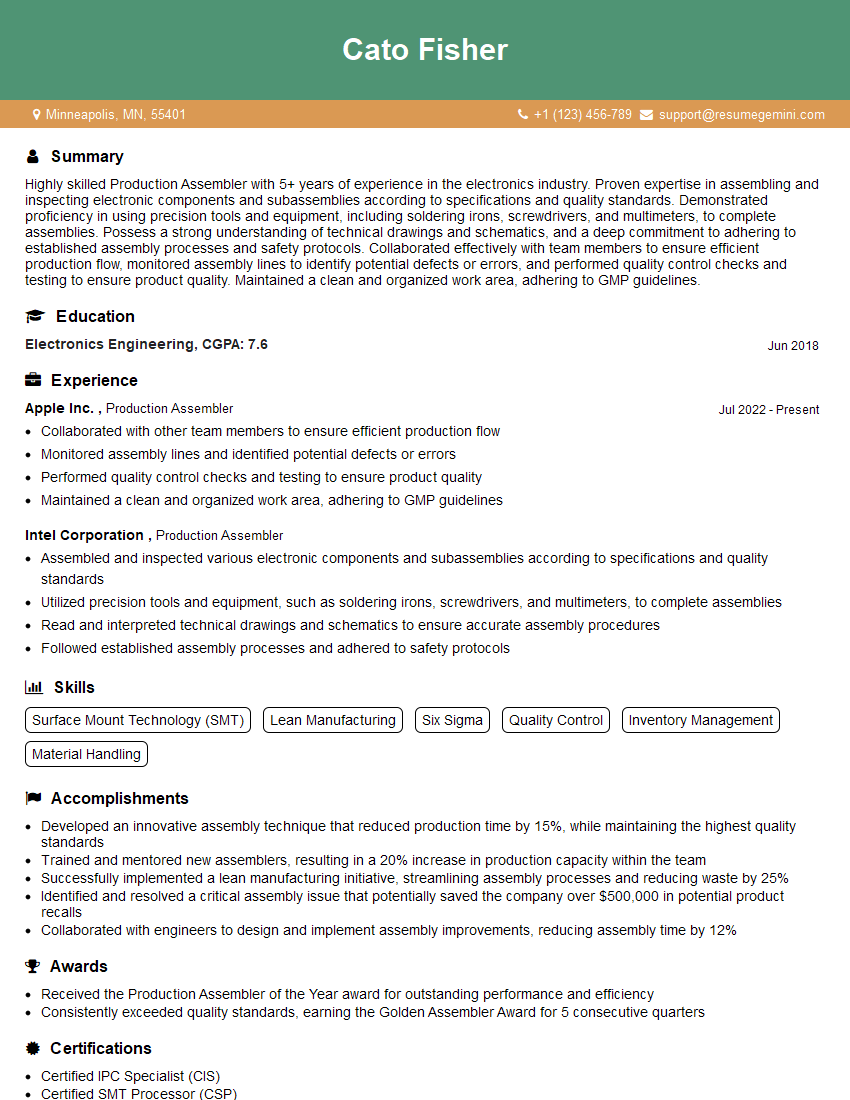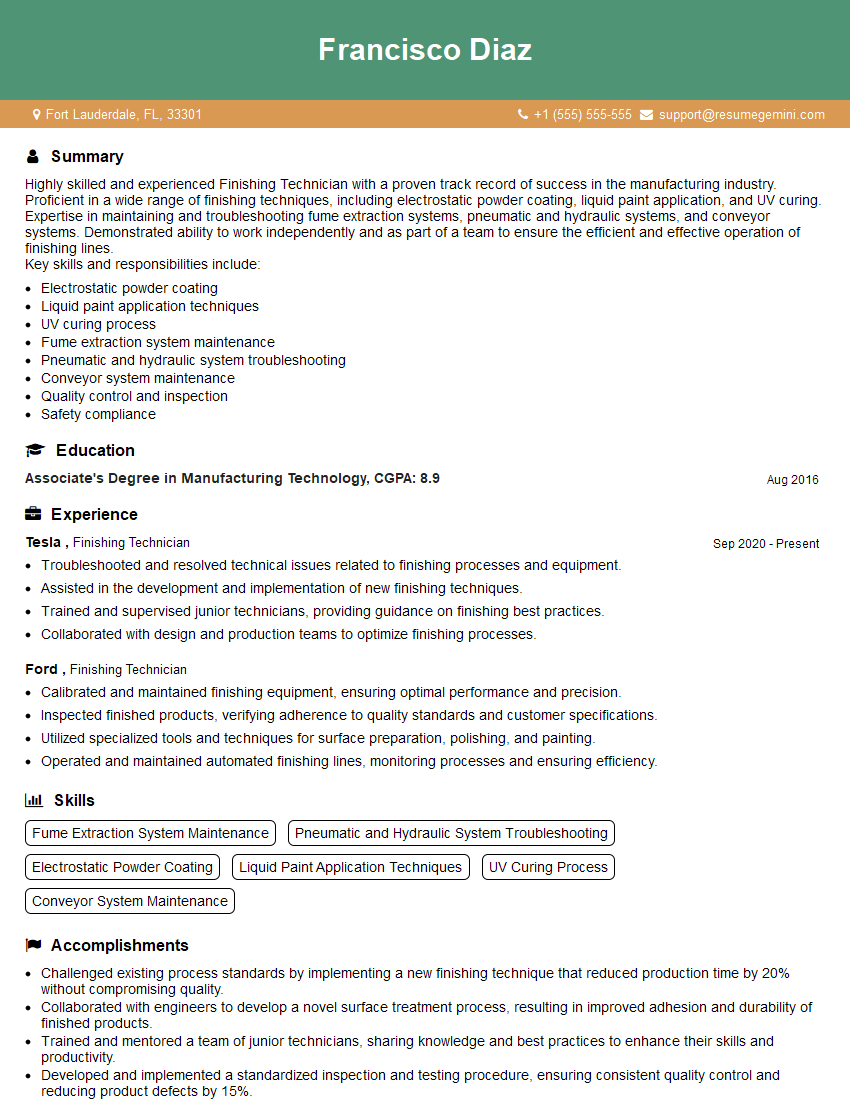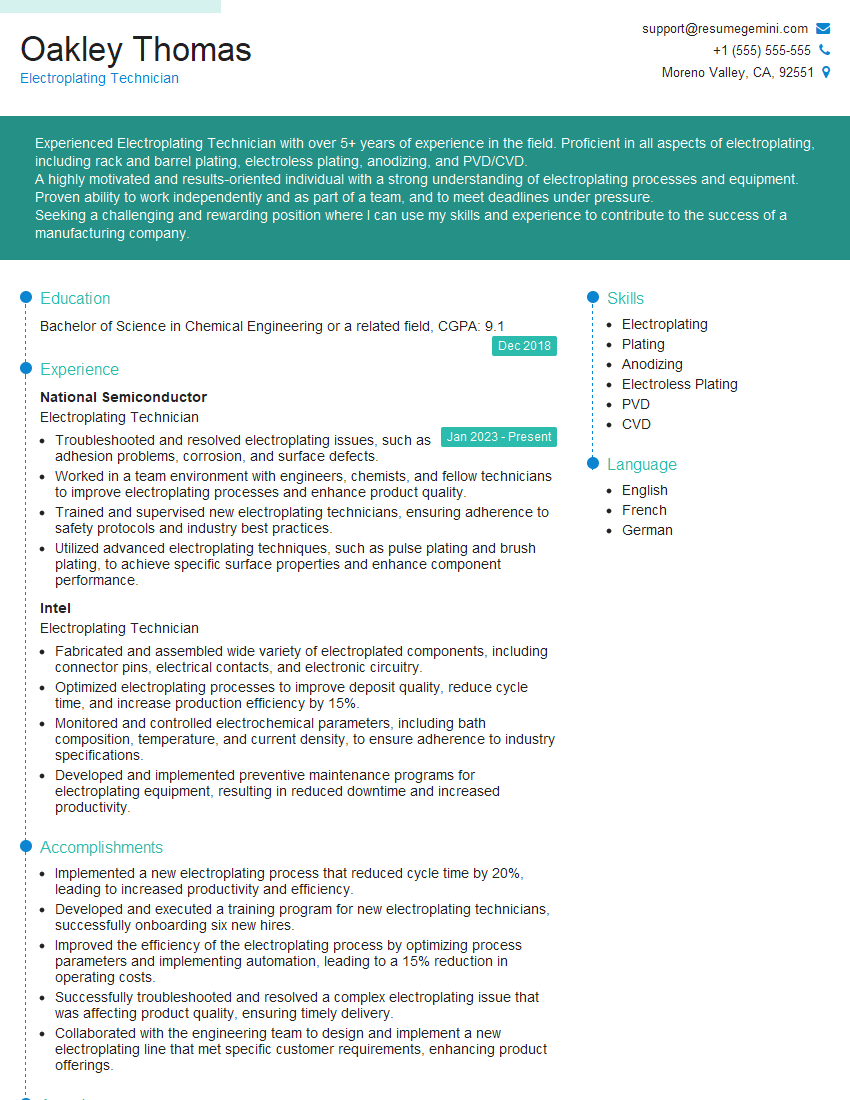The thought of an interview can be nerve-wracking, but the right preparation can make all the difference. Explore this comprehensive guide to Assembly and Finishing Techniques interview questions and gain the confidence you need to showcase your abilities and secure the role.
Questions Asked in Assembly and Finishing Techniques Interview
Q 1. Describe your experience with different assembly methods (e.g., hand assembly, automated assembly).
My experience spans both hand assembly and automated assembly methods. Hand assembly, while slower, allows for greater flexibility and precision, particularly with complex or delicate components. I’ve extensively used hand tools to assemble intricate electronic devices, requiring careful alignment and the use of specialized fasteners. Think of assembling a high-end watch – each part needs meticulous placement. On the other hand, automated assembly, using robotic systems or assembly lines, is ideal for high-volume, repetitive tasks where speed and consistency are paramount. I’ve worked on projects involving automated assembly of automotive parts, using systems that incorporate vision systems for quality control and precise placement. The key difference lies in the scale and complexity; hand assembly suits low-volume, high-precision work, while automated assembly excels in high-volume, standardized production.
Q 2. Explain your understanding of different finishing techniques (e.g., painting, powder coating, plating).
My understanding of finishing techniques encompasses a wide range of processes, each chosen based on the material, desired aesthetic, and required durability. Painting offers a diverse palette of colors and finishes, from simple enamel paints to specialized coatings like UV-resistant or anti-corrosive paints. I’ve worked extensively with both spray painting and dip coating techniques. Powder coating provides a durable, chip-resistant finish, often preferred for outdoor applications or components needing high wear resistance. Its electrostatic application ensures uniform coverage, minimizing material waste. Electroplating, like chrome or nickel plating, offers both aesthetic appeal and enhanced corrosion protection, often used on metal components to improve durability and appearance. The selection of the finishing technique is critical to the overall product quality and lifespan; each method offers a unique set of advantages and is best suited for different applications.
Q 3. What quality control measures do you employ during assembly and finishing processes?
Quality control is paramount throughout the assembly and finishing processes. During assembly, I employ several methods, including visual inspection at each stage, dimensional checks using calibrated tools (like calipers and micrometers), and functional testing to ensure components work as designed. Statistical Process Control (SPC) charts are used to track key parameters and identify potential problems proactively. For finishing, quality checks involve assessing the uniformity of the coating (thickness, color, texture), checking for defects such as pinholes, orange peel, or runs, and ensuring that the finish meets the specified standards. We regularly use colorimeters to ensure consistent color matching. In both assembly and finishing, thorough documentation of each step, including date, time, inspector, and any discrepancies found, is essential for traceability and continuous improvement.
Q 4. How do you handle assembly errors or defects?
Handling assembly errors or defects requires a systematic approach. First, the defect is thoroughly documented – its type, location, and the stage of the process where it occurred. This helps in identifying root causes. Then, depending on the severity of the defect, different actions are taken. Minor defects might be corrected through rework – such as replacing a faulty component or re-applying a finish. Major defects might necessitate scrapping the entire assembly. A root cause analysis is then performed to prevent similar errors in the future. This often involves reviewing assembly procedures, improving operator training, recalibrating equipment, or improving material quality control. The goal is not just to fix the immediate problem but also to implement preventive measures to avoid recurrence.
Q 5. Describe your experience with using different hand tools and power tools in assembly.
My experience with hand and power tools is extensive. Hand tools include screwdrivers (Phillips, flathead, Torx), wrenches (adjustable, socket), pliers (needle-nose, slip-joint), and various specialized tools depending on the assembly. Power tools range from electric drills and impact drivers to pneumatic tools such as rivet guns and air ratchets. Safety is always a priority when using power tools; I always ensure appropriate safety measures are followed, including wearing safety glasses, gloves, and hearing protection where necessary. Proficiency in using these tools is crucial for efficient and accurate assembly, understanding their capabilities and limitations is critical for choosing the right tool for the job and preventing damage to the components.
Q 6. How familiar are you with different types of assembly drawings and blueprints?
I’m highly familiar with various types of assembly drawings and blueprints, including orthographic projections, isometric drawings, and exploded views. I understand how to interpret dimensions, tolerances, materials specifications, and assembly sequences from these documents. Understanding these drawings is fundamental to accurate assembly. For example, orthographic views show different sides of an object, while exploded views show how the parts fit together. I can read and interpret symbols and annotations, such as weld symbols, surface finish specifications, and tolerances. Familiarity with CAD software (such as SolidWorks or AutoCAD) further enhances my ability to interpret and work with these drawings effectively.
Q 7. What is your experience with working in a team environment on an assembly line?
I have significant experience working in team environments on assembly lines. Effective teamwork is essential for maintaining production efficiency and quality. In these settings, communication and coordination are paramount. I am comfortable contributing to a team, following established procedures, and working collaboratively with colleagues to achieve shared goals. I understand the importance of respecting individual roles, contributing to problem-solving, and maintaining a positive and productive working environment. My experience includes both leading and contributing within teams, adapting my approach depending on the project’s needs and team dynamics. I believe open communication and mutual respect are vital ingredients in a successful team environment.
Q 8. How do you maintain a clean and organized workspace during assembly and finishing?
Maintaining a clean and organized workspace is paramount in assembly and finishing for efficiency, safety, and quality control. Think of it like a chef’s kitchen – a cluttered space leads to errors and accidents.
- 5S Methodology: I utilize the 5S methodology (Sort, Set in Order, Shine, Standardize, Sustain). This involves regularly sorting through tools and materials, organizing them logically, cleaning the workspace, standardizing processes for organization, and maintaining the system over time.
- Designated Areas: I establish specific areas for different tasks. For instance, a dedicated area for prepping parts, another for assembly, and a final area for finishing and inspection. This prevents cross-contamination and simplifies workflow.
- Regular Cleaning: Regular cleaning – including sweeping, vacuuming, and wiping down surfaces – is essential to remove debris and prevent accidents. I also use appropriate cleaning solutions for specific materials to avoid damage.
- Tool Organization: Tools are kept in designated holders or cabinets, labeled clearly, and returned to their places after each use. This prevents loss, damage, and wasted time searching.
- Waste Management: Proper waste disposal is crucial. I use designated containers for different types of waste (e.g., metal scraps, plastic, hazardous materials) according to company and safety regulations.
By consistently adhering to these practices, I ensure a safe, efficient, and high-quality output.
Q 9. Describe your experience with troubleshooting assembly line issues.
Troubleshooting assembly line issues requires a systematic approach. Imagine it like diagnosing a car problem – you need to identify the root cause, not just the symptom.
- Identify the Problem: First, precisely define the issue. Is it a slowdown, faulty product, or safety hazard? Data collection (e.g., defect rates, production logs) is vital here.
- Root Cause Analysis: I use tools like the 5 Whys (asking ‘why’ repeatedly to uncover the underlying cause) or Fishbone diagrams to identify the root cause. For example, if a part is consistently misaligned, the root cause might be a faulty jig or improper training.
- Implement Corrective Actions: Once the root cause is identified, implement the appropriate corrective actions. This might involve adjusting equipment settings, retraining personnel, replacing faulty parts, or modifying the assembly process.
- Preventative Measures: After resolving the issue, implement preventive measures to avoid recurrence. This could include improved quality control checks, process standardization, or better training programs.
In a past role, we experienced a significant increase in defective units due to a faulty batch of screws. Through careful analysis, we identified the defective screws, quarantined the batch, and implemented stricter quality checks on incoming materials. This prevented further issues and improved product quality.
Q 10. What safety precautions do you follow during assembly and finishing operations?
Safety is paramount. I always follow established safety procedures and regulations, viewing them not as guidelines, but as essential practices.
- Personal Protective Equipment (PPE): Consistent use of appropriate PPE, such as safety glasses, gloves, hearing protection, and respirators (depending on the materials and processes), is mandatory.
- Machine Safety: When operating machinery, I ensure all safety guards are in place, lockout/tagout procedures are followed before maintenance or repairs, and I never operate equipment beyond my training or certification.
- Material Safety Data Sheets (MSDS): I always review the MSDS for any materials I handle to understand potential hazards and necessary precautions.
- Ergonomics: I maintain proper posture and lifting techniques to avoid musculoskeletal injuries. I also utilize ergonomic tools and equipment whenever possible.
- Emergency Procedures: I am familiar with the emergency procedures for the facility, including fire exits, first aid stations, and emergency contact information.
Safety isn’t just about following rules; it’s about a mindset of proactive risk mitigation. A minor cut can lead to infection, a misplaced tool can cause serious injury. Consistent attention to detail prevents accidents.
Q 11. How do you ensure the quality of finished products?
Ensuring quality relies on a multi-faceted approach, starting from the design stage and continuing through the entire process.
- Quality Control Checks: I perform regular quality control checks at various stages of the assembly and finishing process. This includes visual inspections, dimensional checks using measuring tools, and functional tests.
- Statistical Process Control (SPC): Understanding and applying SPC techniques helps to identify and address variations in the manufacturing process, preventing defects from occurring in the first place.
- Documentation: Maintaining detailed records of processes, materials used, and inspections is essential for traceability and troubleshooting.
- Continuous Improvement: I actively participate in continuous improvement initiatives, identifying areas for optimization and implementing changes to enhance product quality and reduce defects. This might involve process improvements, better training, or new equipment.
For example, in a previous project involving intricate electronic assemblies, we implemented a visual inspection checklist at each assembly step and a final functional test. This drastically reduced defects and improved customer satisfaction.
Q 12. What is your experience with using measuring tools (e.g., calipers, micrometers)?
I have extensive experience using various measuring tools, such as calipers, micrometers, dial indicators, and height gauges. Accuracy is critical in assembly and finishing, and these tools are essential for ensuring precise measurements.
- Calipers: I use calipers for measuring outside diameters, inside diameters, and depths. I understand the different types of calipers (e.g., vernier, digital) and their applications.
- Micrometers: Micrometers provide even greater precision than calipers, allowing for extremely accurate measurements. I am proficient in using both outside and inside micrometers.
- Dial Indicators: I utilize dial indicators for measuring surface flatness, runout, and other dimensional variations.
- Height Gauges: Height gauges provide precise measurements of height and depth.
I understand the importance of proper calibration and maintenance of these tools to maintain accuracy. I regularly check for calibration and ensure the tools are in good working order before use.
Q 13. Explain your experience with different types of adhesives and sealants.
My experience with adhesives and sealants spans various types, each with its unique properties and applications. Choosing the right adhesive is crucial for both strength and longevity.
- Epoxy Resins: I’m familiar with epoxy resins for high-strength bonding of metal, wood, and composites. I understand the importance of proper mixing ratios and curing times.
- Cyanoacrylates (Super Glue): I use cyanoacrylates for quick-setting bonds, understanding their limitations in terms of strength and temperature resistance.
- Polyurethane Adhesives: Polyurethane adhesives offer versatility, suitable for various substrates and applications, including gap-filling.
- Sealants (Silicone, Acrylic, etc.): I have experience with various sealants, understanding the differences in their flexibility, durability, and resistance to chemicals and weather. The choice depends on the application and environmental conditions.
I understand the importance of proper surface preparation before applying any adhesive or sealant, as it directly affects bond strength and longevity. I also understand safety precautions, such as ventilation when working with certain adhesives.
Q 14. Describe your experience with automated assembly equipment.
My experience with automated assembly equipment includes operating, maintaining, and troubleshooting various automated systems, from simple robotic arms to complex automated assembly lines.
- Robotic Systems: I’m comfortable programming and operating robotic arms for various assembly tasks, including pick-and-place operations, welding, and material handling. I understand the importance of safety protocols when working with robots.
- Automated Assembly Lines: I have experience working on automated assembly lines, understanding their control systems, sensor technologies, and integration with other equipment.
- PLC Programming (Basic): I possess basic knowledge of Programmable Logic Controllers (PLCs) and their role in controlling automated systems. I can troubleshoot basic PLC programs and make minor adjustments as needed.
- Preventive Maintenance: I understand the importance of preventive maintenance for automated equipment to ensure smooth operation and prevent breakdowns.
In a previous role, I helped optimize an automated assembly line by improving the robot’s programming, reducing cycle times, and increasing production efficiency by 15%. This involved careful analysis of the existing system, identifying bottlenecks, and implementing targeted improvements.
Q 15. How do you prioritize tasks and manage your time during assembly and finishing?
Prioritizing tasks and managing time in assembly and finishing is crucial for efficiency and meeting deadlines. I utilize a combination of techniques, starting with a thorough review of the project specifications and bill of materials. This helps me identify critical path activities – those tasks that directly impact the overall completion time.
I then employ methods like the Eisenhower Matrix (urgent/important) to categorize tasks and prioritize accordingly. High-impact, time-sensitive tasks get immediate attention. I also break down larger tasks into smaller, more manageable sub-tasks, making progress more visible and less daunting. This allows for better tracking and adjustment throughout the process. Finally, I use time-blocking techniques to schedule specific tasks within my workday, ensuring dedicated time slots for focused work. Regular check-ins and adjustments are key to staying on track.
For example, in a recent project involving the assembly of a complex piece of machinery, I identified the precise alignment of certain components as critical path. I dedicated a specific block of time to this, minimizing potential delays and ensuring accuracy. Using this combined approach ensures I can effectively manage even the most demanding projects.
Career Expert Tips:
- Ace those interviews! Prepare effectively by reviewing the Top 50 Most Common Interview Questions on ResumeGemini.
- Navigate your job search with confidence! Explore a wide range of Career Tips on ResumeGemini. Learn about common challenges and recommendations to overcome them.
- Craft the perfect resume! Master the Art of Resume Writing with ResumeGemini’s guide. Showcase your unique qualifications and achievements effectively.
- Don’t miss out on holiday savings! Build your dream resume with ResumeGemini’s ATS optimized templates.
Q 16. What is your experience with Lean Manufacturing principles?
Lean Manufacturing principles are integral to my approach to assembly and finishing. My experience encompasses applying techniques like 5S (Sort, Set in Order, Shine, Standardize, Sustain) for workplace organization, resulting in reduced waste and improved efficiency. I’m proficient in implementing Kaizen (continuous improvement) methodologies, identifying and eliminating bottlenecks in the production process. This involves actively seeking ways to improve workflow, reduce errors, and optimize resource utilization.
I have practical experience in implementing Kanban systems for managing workflow visually and ensuring smooth material flow. My work on a previous project involved using Kanban boards to track the progress of components through the assembly and finishing stages, facilitating better coordination and reducing lead times. Furthermore, I understand the importance of reducing waste in all its forms – motion, waiting, over-processing, inventory, transportation, over-production and defects. My focus is always on streamlined processes and minimal waste.
Q 17. How do you handle working with tight deadlines?
Working under tight deadlines requires a proactive and adaptable approach. My strategy involves immediately assessing the scope of work and identifying potential challenges. This includes clarifying any ambiguities in the requirements and establishing clear communication channels with stakeholders. I then prioritize tasks based on their criticality and potential impact on the deadline. This frequently involves parallel processing, where multiple tasks are handled concurrently wherever feasible without compromising quality.
For instance, in a recent project, I delegated less critical sub-tasks while focusing on the most time-sensitive aspects myself. Effective communication with my team members throughout the process is essential, particularly when encountering unforeseen obstacles. It is crucial to accurately assess the situation and propose effective solutions promptly. The ability to adapt and adjust the schedule in a timely fashion is paramount when working under pressure. Transparency and prompt communication with stakeholders are essential in ensuring that the project continues to remain on track.
Q 18. Describe your experience with different types of surface preparation techniques.
My experience with surface preparation techniques is extensive and spans various methods, each suited for different materials and finishes. I’m proficient in mechanical methods such as sanding (using various grits to achieve the desired smoothness), grinding, and blasting (abrasive blasting for cleaning and surface roughening). I also possess expertise in chemical methods including degreasing, etching, and chemical conversion coatings which create a chemically bonded layer to enhance adhesion and corrosion resistance.
For example, when preparing metal surfaces for painting, I might use a combination of abrasive blasting to remove any rust or contaminants followed by a degreasing process to ensure the paint adheres properly. For wood, I might use sanding to achieve a specific level of smoothness before applying a stain or varnish. The choice of method depends on several factors including the substrate material, desired surface finish, and the type of coating to be applied. Understanding the nuances of each technique is essential for optimal results.
Q 19. How familiar are you with different types of coatings and their properties?
My familiarity with coatings is broad, encompassing various types and their specific properties. I’m knowledgeable about paints (water-based, solvent-based, powder coatings), their varying levels of durability, gloss, and color retention. I understand the differences in their application methods – spraying, brushing, dipping, and electrostatic application. I’m also experienced with varnishes and lacquers for protecting and enhancing the appearance of wood and other materials. Furthermore, I’m skilled in using powder coatings, which offer excellent durability and resistance to corrosion and scratches, often used on metals. I’m also familiar with specialized coatings like electroplating (e.g., chrome, nickel) and anodizing (for aluminum) for decorative and protective purposes.
Understanding the properties of different coatings, like their chemical resistance, UV resistance, flexibility, and hardness, is critical in choosing the appropriate coating for a specific application. For example, selecting a UV-resistant coating for outdoor furniture is crucial for longevity. A detailed understanding of these materials is essential for ensuring the quality and durability of the final product.
Q 20. What are the common causes of defects in assembly and finishing processes?
Defects in assembly and finishing processes can stem from various sources, broadly categorized into human error, material flaws, and process inadequacies. Human error includes improper assembly techniques, incorrect application of coatings, and inadequate quality control. Material flaws might include defects in the raw materials themselves, like inconsistencies in dimensions, surface imperfections or internal structural weaknesses. Process inadequacies encompass issues like improper equipment calibration, insufficient cleaning or preparation, incorrect curing times or temperatures for coatings, and inadequate environmental controls (e.g., temperature, humidity).
Examples include incorrect torque during fastening (leading to loose parts), paint runs or orange peel (due to improper spraying techniques or environmental factors), and scratches or dents caused by careless handling. Identifying the root cause of a defect is crucial for implementing corrective actions and preventing recurrence.
Q 21. How do you prevent defects in assembly and finishing?
Preventing defects requires a multi-pronged approach focused on proactive measures throughout the entire process. This includes rigorous quality control at every stage. Proper training for personnel on correct assembly techniques, coating application methods, and quality control procedures is paramount. This training should emphasize attention to detail and the importance of following established procedures. Regular equipment maintenance and calibration are essential to ensure consistency and accuracy. This is supplemented by thorough inspection of raw materials upon receipt and regular checks throughout the manufacturing process, using appropriate tools like calipers, micrometers, and visual inspection techniques.
Implementing a robust process control system, including standardized operating procedures (SOPs) and clear work instructions, minimizes variability and ensures consistent quality. Statistical Process Control (SPC) techniques can identify potential issues before they lead to defects. In addition, maintaining a clean and organized work environment minimizes the risk of damage and contamination. A culture of continuous improvement through Kaizen and feedback mechanisms ensures ongoing identification and elimination of potential defect sources.
Q 22. Explain your understanding of different materials used in assembly (e.g., metals, plastics, composites).
Selecting the right materials is crucial for successful assembly and finishing. My experience encompasses a wide range of materials, each with unique properties impacting the final product’s performance and longevity.
- Metals: I’ve worked extensively with various metals like steel (both carbon and stainless), aluminum, and titanium. Steel offers strength and durability, ideal for high-stress applications, but its susceptibility to corrosion needs careful consideration. Aluminum provides a lightweight yet strong option, excellent for aerospace or automotive parts, but its softness limits its use in high-impact scenarios. Titanium’s high strength-to-weight ratio and corrosion resistance makes it perfect for demanding applications, although it is significantly more expensive.
- Plastics: Plastics offer versatility in design and cost-effectiveness. I’ve used thermoplastics like ABS (Acrylonitrile Butadiene Styrene) for its impact resistance and ease of molding, and Polypropylene (PP) for its chemical resistance. Thermosets, like epoxy resins, are known for their high strength and heat resistance, perfect for specific components requiring stability and durability. Material selection depends heavily on factors like the intended use, required strength, and environmental conditions.
- Composites: Composites, such as fiberglass reinforced polymers (FRP) or carbon fiber reinforced polymers (CFRP), combine the strength of fibers with the matrix material’s flexibility. CFRP offers exceptional strength-to-weight ratios, commonly used in aerospace and high-performance applications. FRP, more cost-effective, finds applications in construction and automotive industries. Working with composites requires specialized handling and finishing techniques.
For instance, in a recent project involving the assembly of a robotic arm, we chose aluminum for its lightweight nature and steel for the high-stress joints to ensure both functionality and durability.
Q 23. How do you ensure compliance with safety regulations and standards?
Safety is paramount in assembly and finishing. My approach is proactive, starting with a thorough understanding and strict adherence to all relevant safety regulations and standards, such as OSHA (Occupational Safety and Health Administration) guidelines.
- Risk Assessment: I always begin by conducting a thorough risk assessment of each assembly process, identifying potential hazards like sharp edges, moving parts, chemical exposure, or electrical risks.
- Personal Protective Equipment (PPE): Ensuring the appropriate PPE is used is crucial. This includes safety glasses, gloves, hearing protection, respirators, and any specialized equipment needed for the task. I always enforce PPE usage and provide regular training to ensure everyone understands its importance.
- Machine Safeguarding: All machinery is regularly inspected and maintained to ensure safety features are functioning correctly, including emergency stop buttons, guards, and interlocks. I am skilled in implementing and monitoring safety protocols for all equipment.
- Lockout/Tagout Procedures: I meticulously follow lockout/tagout procedures to prevent accidental activation of machinery during maintenance or repair. This ensures the safety of personnel working on the equipment.
- Documentation and Training: All safety procedures are documented, and regular training sessions are conducted to reinforce safe practices. This ensures that everyone is aware of and compliant with safety regulations.
For example, in one instance, we identified a potential pinch point in a machine during the assembly process. By implementing a safety guard and providing additional training, we eliminated the risk entirely.
Q 24. What is your experience with maintaining assembly tools and equipment?
Maintaining assembly tools and equipment is essential for ensuring both productivity and safety. My experience includes regular preventative maintenance, troubleshooting malfunctions, and implementing a systematic approach to equipment management.
- Preventative Maintenance Schedules: I develop and implement preventative maintenance schedules for all tools and equipment, including regular cleaning, lubrication, and inspection. This prevents unexpected breakdowns and ensures the longevity of the equipment.
- Calibration and Verification: I understand the importance of calibration and regularly verify the accuracy of measuring tools and equipment to maintain precision in the assembly process.
- Troubleshooting and Repair: I am proficient in diagnosing and resolving mechanical and electrical issues related to assembly tools and equipment. This minimizes downtime and ensures the smooth flow of operations.
- Inventory Management: I participate in inventory management, ensuring that the right tools and equipment are available when needed. This prevents delays and ensures efficiency.
- Tool Organization: A well-organized workspace is crucial for safety and efficiency. I implement and maintain systems for storing and organizing tools, ensuring that they are readily accessible and in good condition.
In a recent situation where a pneumatic tool started malfunctioning, I quickly identified the problem—a faulty air regulator—replaced it, and ensured minimal production disruption.
Q 25. Describe your experience with documenting assembly and finishing processes.
Thorough documentation of assembly and finishing processes is critical for quality control, training, and future reference. My approach involves detailed written procedures, visual aids, and digital documentation.
- Work Instructions: I create clear and concise work instructions, including step-by-step procedures, diagrams, and specifications, ensuring that every assembly step is clearly documented.
- Bill of Materials (BOM): Accurate BOMs are crucial to ensure that all necessary components are available and used correctly. I maintain updated BOMs for all assembly projects.
- Visual Aids: Pictures, videos, and other visual aids are incorporated into the documentation to provide a clearer understanding of the assembly processes.
- Digital Documentation: I utilize digital platforms to store and manage assembly documentation, including CAD drawings, process flowcharts, and quality control records. This enhances accessibility and collaboration.
- Version Control: I utilize version control systems to track changes and updates made to the documentation, ensuring that everyone is working with the most current information.
For example, in documenting the assembly of a complex electronic device, I created a detailed video tutorial alongside the written work instructions, making it easier for new team members to learn the process.
Q 26. How do you contribute to continuous improvement in assembly and finishing processes?
Continuous improvement is a core principle in assembly and finishing. My approach is data-driven, using various methods to identify areas for enhancement and streamline processes.
- Data Analysis: I regularly analyze production data, including cycle times, defect rates, and material usage, to identify bottlenecks and areas needing optimization.
- Kaizen Events: I actively participate in Kaizen events (continuous improvement workshops) to brainstorm and implement solutions to identified problems.
- Lean Manufacturing Principles: I am familiar with lean manufacturing principles and apply them to eliminate waste, reduce lead times, and improve overall efficiency.
- 5S Methodology: I implement and maintain a 5S workplace organization system (Sort, Set in Order, Shine, Standardize, Sustain) to create a more efficient and safer working environment.
- Process Mapping: I use process mapping techniques to visualize the assembly process, identify inefficiencies, and suggest improvements.
In one instance, by analyzing production data, we identified a repetitive motion that was causing strain injuries. By implementing ergonomic changes and redesigning a workstation, we significantly reduced injuries and improved employee satisfaction.
Q 27. Describe your experience with working with different types of jigs and fixtures.
Jigs and fixtures are indispensable for ensuring consistent and accurate assembly. My experience covers a variety of types, each suited for different applications.
- Welding Fixtures: I have experience with welding fixtures designed to hold components precisely during welding, ensuring consistent weld quality and minimizing distortion.
- Drill Jigs: Drill jigs guide drill bits to ensure accurate hole placement, crucial for repeatable assembly.
- Assembly Fixtures: These fixtures hold components in place during assembly, simplifying the process and improving repeatability. They can be simple clamps or complex CNC-machined units.
- Inspection Fixtures: These fixtures are used to ensure components meet specified tolerances and dimensions. They are often used in quality control.
- Custom Fixture Design: I’ve been involved in the design and fabrication of custom jigs and fixtures tailored to specific assembly requirements. This often involves CAD software and collaboration with machinists.
For example, in assembling a complex circuit board, we designed a custom fixture to hold the components precisely during soldering, ensuring consistent solder joints and reducing rework.
Q 28. What is your experience with using Computer-Aided Design (CAD) software for assembly?
CAD software is an essential tool in modern assembly and finishing. I am proficient in using various CAD software packages to design, model, and simulate assembly processes.
- 3D Modeling: I use CAD software to create 3D models of assemblies, allowing for visualization and analysis before physical production. This helps identify potential issues early on.
- Assembly Simulation: I can simulate the assembly process virtually, identifying potential interference issues or design flaws before they manifest in physical prototypes. This drastically reduces costly rework.
- Tolerance Analysis: CAD software allows for detailed tolerance analysis, ensuring components fit together correctly and meet required specifications.
- Documentation Generation: CAD software facilitates the generation of detailed drawings and documentation necessary for manufacturing and assembly.
- Collaboration: CAD software enables seamless collaboration with design engineers and manufacturing teams, facilitating efficient communication and problem-solving.
In a recent project, using CAD software to simulate the assembly of a complex mechanism allowed us to identify a clearance issue between two components, preventing potential production delays and enhancing the product’s reliability.
Key Topics to Learn for Assembly and Finishing Techniques Interview
- Understanding Assembly Processes: Explore different assembly methods (manual, automated, robotic), jigs and fixtures, and quality control checks at each stage.
- Practical Application: Be prepared to discuss your experience with specific assembly techniques, including troubleshooting common issues and optimizing assembly lines for efficiency.
- Finishing Techniques & Materials: Gain a solid understanding of various finishing methods (painting, powder coating, plating, etc.), their applications, and the properties of different materials used in the finishing process.
- Quality Control & Inspection: Learn about quality control procedures, including inspection techniques, defect identification, and documentation. Understand industry standards and relevant certifications.
- Safety Procedures & Regulations: Demonstrate familiarity with relevant safety protocols, including the proper use of equipment and personal protective equipment (PPE) in assembly and finishing environments.
- Lean Manufacturing Principles: Understand how lean manufacturing principles (such as Kaizen, 5S, and Kanban) can be applied to optimize assembly and finishing processes.
- Problem-Solving & Troubleshooting: Practice your ability to diagnose and solve problems related to assembly and finishing, focusing on efficient and effective solutions.
- Teamwork & Communication: Highlight your experience working collaboratively within a team environment and effectively communicating technical information.
Next Steps
Mastering Assembly and Finishing Techniques is crucial for career advancement in manufacturing and related industries. A strong understanding of these techniques opens doors to higher-paying roles and increased responsibility. To maximize your job prospects, it’s essential to create an ATS-friendly resume that highlights your skills and experience effectively. We strongly recommend using ResumeGemini to build a professional and impactful resume. ResumeGemini offers tools and resources to help you craft a compelling narrative, and examples of resumes tailored to Assembly and Finishing Techniques are available to guide you. Take the next step toward your dream career today!
Explore more articles
Users Rating of Our Blogs
Share Your Experience
We value your feedback! Please rate our content and share your thoughts (optional).
What Readers Say About Our Blog
Hello,
We found issues with your domain’s email setup that may be sending your messages to spam or blocking them completely. InboxShield Mini shows you how to fix it in minutes — no tech skills required.
Scan your domain now for details: https://inboxshield-mini.com/
— Adam @ InboxShield Mini
Reply STOP to unsubscribe
Hi, are you owner of interviewgemini.com? What if I told you I could help you find extra time in your schedule, reconnect with leads you didn’t even realize you missed, and bring in more “I want to work with you” conversations, without increasing your ad spend or hiring a full-time employee?
All with a flexible, budget-friendly service that could easily pay for itself. Sounds good?
Would it be nice to jump on a quick 10-minute call so I can show you exactly how we make this work?
Best,
Hapei
Marketing Director
Hey, I know you’re the owner of interviewgemini.com. I’ll be quick.
Fundraising for your business is tough and time-consuming. We make it easier by guaranteeing two private investor meetings each month, for six months. No demos, no pitch events – just direct introductions to active investors matched to your startup.
If youR17;re raising, this could help you build real momentum. Want me to send more info?
Hi, I represent an SEO company that specialises in getting you AI citations and higher rankings on Google. I’d like to offer you a 100% free SEO audit for your website. Would you be interested?
Hi, I represent an SEO company that specialises in getting you AI citations and higher rankings on Google. I’d like to offer you a 100% free SEO audit for your website. Would you be interested?
good
